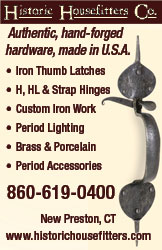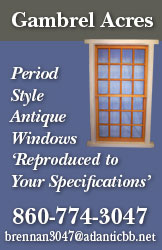Home Structural Products & Services, Stairlifts Structural Products & Services, Stairlifts Furniture, Clocks,
Accessories
Reclaimed Stone Materials
Woodwork, Blinds,
Finishing
Lighting
Kitchen
Floors & Rugs
Fabrics
Paint & Wallpaper Pottery & Tile
Period Hardware Antiques, Folk Art,
Fine Art, Auction Houses
Windows
Interior Design & Architecture
Silver, Cookware, Pewter
Garden
Historic Hotels |
SILAS DEANE HOUSE, 1766, WETHERSFIELD

|
The Silas Deane house, built in 1766, is architecturally unusual for its time and location. Insstead of the typical central hall, four-over-four arrangement, it has an off-center doorway and a very wide entrance hall. The interior gives an impression of great spaciousness. Another unusual feature is the inclusion of four closets.
|
Silas Deane of Wethersfield was one of the most diligent members of the First Continental Congress and of the early days of the Second as well. But he was distrusted by important Nutmeg politicians such as dour Roger Sherman of New Haven and fiery William Williams whom Deane once called "that little malevolent prig in buckram." Deane was not returned to Congress after the winter of 1775-76. His colleague, Eliphalet Dyer, suffered the same fate, and only sherman kept his Philadelphia berth.
Deane was not to be put off by any "rascally junto," however, and managed to get appointments from two secret committees of Congress to go to France in an effort to gain either over- or under-the-counter material assistance for the war bound colonies. Deane's activities abroad are still shrouded in mystery, and his reputation has never recovered from the damage done it by his own odd financial maneuvers and the slanders heaped on him by hostile politicians.
-Christopher Collier |
|
 Front parlor, Deane house. The paneling of this elegant room is original, as is the fireplace surround, finely carved of brownstone from Portland, Connecticut. The Rhode Island mahogany chairs, c. 1770, are from a set of twelve. China Trade porcelain is set on the Philadelphia Chippendale tripod table, c. 1765. The mahogany fire screen, probably English, c. 1750, is fitted with a needlework panel of later date. Front parlor, Deane house. The paneling of this elegant room is original, as is the fireplace surround, finely carved of brownstone from Portland, Connecticut. The Rhode Island mahogany chairs, c. 1770, are from a set of twelve. China Trade porcelain is set on the Philadelphia Chippendale tripod table, c. 1765. The mahogany fire screen, probably English, c. 1750, is fitted with a needlework panel of later date.
|
 |
 |
|

 

  

 
  




|

 Structural Products & Services, Stairlifts
Structural Products & Services, Stairlifts

